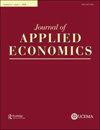Investment in children’s higher education and household asset allocation in China
IF 1.4
4区 经济学
Q3 ECONOMICS
引用次数: 0
Abstract
ABSTRACT This paper explores how the anticipated expenditure on children’s college education affects household asset allocation, applying a two-stage budgeting model of asset demand by using the 2016 China Family Panel Studies Data (CFPS). The empirical results show that if a household plans to send a child to college, the probability of holding risky assets increases by 1.7 percentage points, and the probability of holding investable housing assets increases by 3.8 percentage points. Furthermore, we also find that as the expected year of college entry approaches, households prefer less liquid assets. When the expected year is still far in the future, they prefer liquid assets with high-risk and illiquid assets with high-return. These findings imply that policymakers should make reforms in the financial market and real estate market, as well as provide more kinds of investment products, thereby promoting household investment diversification.中国儿童高等教育投资与家庭资产配置
摘要本文利用2016年中国家庭面板研究数据,应用资产需求的两阶段预算模型,探讨了儿童大学教育的预期支出如何影响家庭资产配置。实证结果显示,如果一个家庭计划送孩子上大学,持有风险资产的概率会增加1.7个百分点,持有可投资住房资产的概率则会增加3.8个百分点。此外,我们还发现,随着预期的大学入学年份的临近,家庭更喜欢流动性较差的资产。当预期的一年还在遥远的未来时,他们更喜欢高风险和非流动性高回报的流动资产。这些发现意味着政策制定者应该在金融市场和房地产市场进行改革,并提供更多种类的投资产品,从而促进家庭投资多元化。
本文章由计算机程序翻译,如有差异,请以英文原文为准。
求助全文
约1分钟内获得全文
求助全文
来源期刊

Journal of Applied Economics
ECONOMICS-
CiteScore
3.00
自引率
0.00%
发文量
57
审稿时长
40 weeks
期刊介绍:
The Journal of Applied Economics publishes papers which make a significant and original contribution to applied issues in micro and macroeconomics. The primary criteria for selecting papers are quality and importance for the field. Papers based on a meaningful and well-motivated research problem that make a concrete contribution to empirical economics or applied theory, in any of its fields, are especially encouraged. The wide variety of topics that are covered in the Journal of Applied Economics include: -Industrial Organization -International Economics -Labour Economics -Finance -Money and Banking -Growth -Public Finance -Political Economy -Law and Economics -Environmental Economics
 求助内容:
求助内容: 应助结果提醒方式:
应助结果提醒方式:


